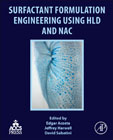
Surfactants are molecules that contain groups that are water-loving (hydrophilic) and oil-loving (lipophilic). The central question in formulations is often which of the two portions dominate the behavior of the surfactant. For many years that question was answered in terms of the surfactant structure only. However, the modern view is that the hydrophilic-lipophilic nature of the surfactant is the result of surfactant structure and formulation conditions (nature of the oil, temperature, aqueous phase composition) as captured by a semi-empirical equation called the hydrophilic-lipophilic difference (HLD). The HLD is a dimensionless number that indicate the approach to the point where the surfactant inverts its solubility from being water-soluble (negative HLD) to oil-soluble (positive HLD). The HLD alone is a good indicator of how the formulation could behave but it does not produce any formulation property that can be used to predict product performance. The net-average curvature (NAC) are a set of equations that take the value of HLD to predict the properties of the formulation, such as oil (and/or water) solubilization capacity, interfacial tension, phase diagrams, contact angle and others. The book will not only introduce the reader to HLD-NAC but also to the practical use of these concepts in numerous applications ranging from application in the petroleum industry, to environmental remediation, to food, cosmetic and pharmaceutical applications, and even nanotechnology. The last part of the book will look at the molecular origins of the empirical terms in HLD via the Integrated Free Energy Model (IFEM). Concentrates on the HLD and NAC, providing industrially-relevant examplesProvides the only single depository for HLD parametersBalances theory and application, with insights from both academic and industrial authorsIncludes examples relevant to a wide range of fields, with practical guides on how to go from the formulation objective(s) to an actual formulation design INDICE: Section I: Hydrophilic-lipophilic difference (HLD) fundamentals 1. The HLD-NAC in a nutshell: an introduction to the principles and uses of HLD-NAC. 2. History and evolution of the HLD 3. Surfactant mixtures and the measurement of characteristic curvature (Cc) 4. Oil mixtures and the measurement of equivalent alkane carbon number (EACN) 5. Effect of electrolytes, polymers, co-solvents and additives Section II: Hydrophilic-lipophilic difference (HLD) applications 6. Use of HLD in Surfactant-Enhanced Oil Recovery and Aquifer Remediation 7. Use of HLD for corrosion inhibitors and flow assurance chemicals 8. Use of HLD in Detergent formulations 9. Use of HLD in Fragrance formulation 10. High-throughput HLD phase scans for surfactant characterization and formulation. 11. HLD-guided surfactant design for enhanced oil recovery applications 12. High-throughput HLD-guided formulation design for latex and agrochemical formulations 13. HLD-guided surfactant structure-performance relationship in cold detergency applications 14. HLD-guided design of self-emulsifying drug delivery applications. 15. HLD-guided design of vegetable oil extraction technology Section III: Net-Average Curvature (NAC) fundamentals 16. History and evolution of NAC. 17. Prediction of phase diagrams for surfactant-oil-water (SOW) and surfactant-water (SW) systems 18. Prediction of interfacial tension, rigidity, emulsion formation and stability 19. Prediction of oil-water-solid wettability Section IV: Applications of the net-average curvature 20. HLD-NAC in practical applications 21. HLD-NAC in reservoir simulation 22. HLD-NAC alternatives in reservoir simulation 23. HLD-NAC design of hard surface cleaning systems 24. HLD-NAC design of microemulsion-templated nanoparticles 25. HLD-NAC design of microemulsion-templated nanostructured polymers 26. HLD-NAC guided design of extended surfactants for enhanced oil recovery operations Section V: The Integrated Free Energy Model (IFEM) 27. Derivation and predictive capabilities of the Integrated Free Energy model 28. Applications of IFEM in detergent formulation development
- ISBN: 978-0-12-821481-7
- Editorial: Academic Press and AOCS Press
- Encuadernacion: Rústica
- Páginas: 335
- Fecha Publicación: 01/09/2021
- Nº Volúmenes: 1
- Idioma: Inglés
